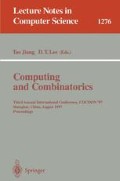Abstract
We investigate the power of regular leaf languages with respect to three different tree shapes: the first one is the case of arbitrary (and thus potentially non-regular) computation trees; the second one is the case of balanced computation trees (these trees are initial segments of full binary trees); and the third one is the case of fall binary computation trees.
Preview
Unable to display preview. Download preview PDF.
References
D.A. Barrington, R. Beigel, S. Rudich: Representing boolean functions as polynomials modulo composite numbers. Proceedings of the 24th Annual ACM Symposium on Theory of Computing (1992), pp. 455–461.
B. Borchert: On the acceptance power of regular languages. Proceedings of the 11th Symp. on Theoretical Aspects of Computer Science (1994), LNCS 775, pp. 533–542.
R. Beigel, J. Gill, U. Hertrampf: Counting classes: thresholds, parity, mods, and fewness. Proceedings of the 7th Symp. on Theoretical Aspects of Computer Science (1990), LNCS 415, pp. 49–57.
D. P. Bovet, P. Crescenzi, R. Silvestri: A uniform approach to define complexity classes. Theoretical Computer Science 104 (1992), pp. 263–283.
J. Cai, L. Hemachandra: On the power of parity polynomial time. Proceedings of the 6th Symp. on Theoretical Aspects of Computer Science(1989), LNCS 349, pp. 229–239.
U. Hertrampf: Locally definable acceptance types for polynomial time machines. Proceedings of the 9th Symp. on Theoretical Aspects of Computer Science(1992), LNCS 577, pp. 199–207.
U. Hertrampf: Über Komplexitätsklassen, die mit Hilfe k-wertiger Funktionen definiert werden (On complexity classes, which can be defined using k-valued functions). Habililtationsschrift, Universität Würzburg (1994).
U. Hertrampf, C. Lautemann, T. Schwentick, H. Vollmer, K.W. Wagner: On the power of polynomial time bit-reductions. Proceedings of the 8th Structure in Complexity Theory Conference (1993), pp. 200–207.
U. Hertrampf, H. Vollmer, K.W. Wagner: On balanced vs. unbalanced computation trees. Mathematical Systems Theory 29 (1996), pp. 411–421.
B. Jenner, P. McKenzie, D. Thérien: Logspace and logtime leaf languages. Proceedings of the 9th Structure in Complexity Theory Conference (1994), pp. 242–254.
N.K. Vereshchagin: Relativizable and non-relativizable theorems in the polynomial theory of algorithms. Izvestija Rossijskoj Akademii Nauk 57 (1993), pp. 51–90. In Russian.
Author information
Authors and Affiliations
Editor information
Rights and permissions
Copyright information
© 1997 Springer-Verlag Berlin Heidelberg
About this paper
Cite this paper
Hertrampf, U. (1997). The shapes of trees. In: Jiang, T., Lee, D.T. (eds) Computing and Combinatorics. COCOON 1997. Lecture Notes in Computer Science, vol 1276. Springer, Berlin, Heidelberg. https://doi.org/10.1007/BFb0045108
Download citation
DOI: https://doi.org/10.1007/BFb0045108
Published:
Publisher Name: Springer, Berlin, Heidelberg
Print ISBN: 978-3-540-63357-0
Online ISBN: 978-3-540-69522-6
eBook Packages: Springer Book Archive

